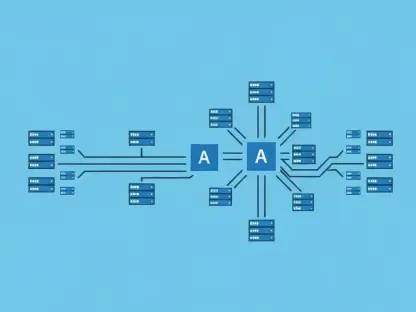In an era where artificial intelligence models are scaling to trillions of parameters, the demand for efficient training infrastructure has never been more pressing, pushing cloud computing platforms to innovate at an unprecedented pace to meet the needs of developers and researchers. Amazon Web Services (AWS) has stepped up to this challenge with a groundbreaking enhancement to its SageMaker HyperPod platform, introducing topology-aware workload scheduling. This advancement promises to transform the landscape of distributed AI training by optimizing how tasks are assigned across clusters of accelerators like GPUs and Trainium chips. By focusing on minimizing network latency and maximizing resource utilization, this technology addresses critical bottlenecks in developing large language models (LLMs) and other complex AI systems. The impact of such innovation extends beyond mere performance gains, offering a glimpse into a future where AI development is faster, more cost-effective, and accessible to a broader range of industries and researchers eager to push boundaries.
Revolutionizing Resource Allocation with Topology Awareness
The core of this latest enhancement lies in its ability to integrate network topology data into scheduling algorithms, ensuring that tasks requiring high data exchange are placed on closely connected nodes within a cluster. This strategic placement reduces communication delays, a persistent issue in distributed training environments where data must travel across multiple accelerators. AWS has reported that such optimization can lead to efficiency gains of up to 40% in resource utilization. This translates into significantly shorter training times for massive AI models, which often take weeks or months to complete. For enterprises and research teams handling trillion-parameter models, this reduction in latency is not just a technical improvement but a game-changer, allowing faster iteration cycles and quicker deployment of AI solutions in competitive markets where time is of the essence.
Beyond the immediate performance benefits, topology-aware scheduling also tackles the financial burden of AI training, which can be prohibitively expensive due to the high cost of compute resources. By ensuring that accelerators are used more effectively, the platform minimizes idle time and wasted capacity, directly impacting operational costs. This is particularly crucial for organizations operating in multi-tenant environments, where resources are shared among various teams or projects. The technology’s ability to prioritize task placement based on network proximity means that even under heavy workloads, the system maintains a high level of efficiency. This balance of speed and cost savings positions the platform as a vital tool for industries like healthcare and finance, where rapid model development can lead to transformative outcomes in patient care or risk analysis.
Enhancing Scalability and Governance for Diverse Workloads
Scalability remains a cornerstone of modern AI infrastructure, and the integration of SageMaker HyperPod with Amazon Elastic Kubernetes Service (EKS) ensures seamless management of complex, heterogeneous clusters. This compatibility allows organizations to handle diverse hardware setups and workload demands without the need for extensive manual configuration. The automation of workload deployment simplifies what was once a daunting task for data scientists, enabling them to focus on model development rather than infrastructure logistics. Community feedback on social platforms highlights a growing appreciation for this streamlined approach, as it reduces the learning curve and operational overhead associated with managing large-scale AI training environments, making advanced tools more accessible to a wider audience.
Equally important is the robust governance framework embedded within the platform, providing administrators with centralized control over resource allocation through intuitive dashboards. These tools enable real-time monitoring, quota setting, and fair distribution of compute power in shared environments, preventing any single team from monopolizing resources. Such oversight is critical in fostering equitable access, especially in large organizations or collaborative research settings where multiple stakeholders compete for limited capacity. The governance features ensure that innovation is not stifled by resource bottlenecks, allowing teams to operate within defined limits while still pushing the boundaries of AI development. This balance of scalability and control underscores the platform’s suitability for high-stakes applications where precision and fairness are paramount.
Real-World Impact and Adoption Challenges
The practical applications of this technology are already evident in fields like natural language processing, where faster fine-tuning of models is achieved by mitigating data bottlenecks during training. Industries such as healthcare and finance benefit immensely from reduced iteration cycles, enabling quicker deployment of AI-driven solutions for diagnostics or market predictions. AWS best practices guides emphasize how topology-aware scheduling accelerates the development of generative AI applications, which are increasingly vital in creating personalized user experiences or automating complex decision-making processes. The tangible benefits in these sectors highlight the platform’s role in translating technical advancements into real-world value, driving efficiency where it matters most and supporting innovation at scale.
However, adopting this cutting-edge technology is not without its hurdles, as data scientists must adapt existing scripts to incorporate topology preferences and gain a deeper understanding of cluster configurations. This learning curve can pose initial challenges, particularly for teams accustomed to traditional training workflows. Despite these obstacles, the long-term payoff is deemed significant, especially in environments handling massive datasets and models where every efficiency gain counts. The integration with existing AWS services like EKS helps ease this transition by providing familiar tools and auto-scaling options such as Karpenter, ensuring that even complex setups remain manageable. Addressing these adoption challenges through training and support will be key to unlocking the full potential of this transformative platform.
Shaping the Future of AI Infrastructure
Reflecting on the strides made with topology-aware scheduling, it’s evident that AWS has set a new benchmark in AI training efficiency through SageMaker HyperPod’s enhancements. This technology tackles critical latency issues and optimizes resource use, delivering faster and more cost-effective development cycles for cutting-edge applications. The seamless integration with scalable services and robust governance tools demonstrates a commitment to balancing innovation with practicality, ensuring that diverse teams can harness powerful AI capabilities without facing insurmountable barriers.
Looking ahead, the focus shifts to further refining these advancements and addressing lingering adoption challenges through comprehensive training and community support. Exploring ways to simplify script adjustments and cluster management will be crucial in broadening access to this technology. As the industry continues to grapple with ever-growing computational demands, staying at the forefront of intelligent resource management will define the next phase of AI infrastructure, promising even greater accessibility and impact across sectors hungry for smarter solutions.









